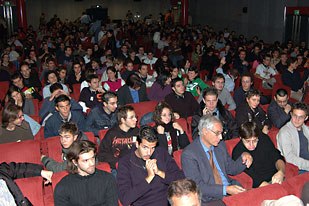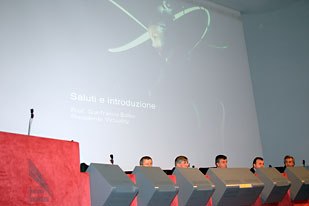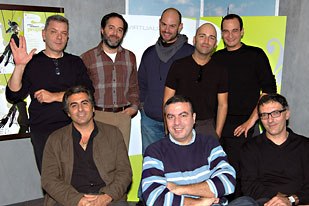In Part 3 about mold making with hard and soft molds, Susannah Shaw shares secrets on casting foam latex and silicone.

The fifth Virtuality Conference comes at the right time; Digital technology and vfx in Italy has been growing. All images © Comitato Organizzatore Virtuality.
There was a time when the Italian city Torino, chief town of the Piemonte region, was the place where the Italian movie industry docked for the first time in the old country, long time before arriving in Rome in 1937, when dux Benito Mussolini founded Cinecittà studios. In fact, FERT Studios of Torino boasted a glorious history that began as far back as 1919, and they were considered for a long time the most active and equipped studio of our peninsula until 1955.
From that time the city has always claimed its role in the national motion picture industry, and political organizations always paid great attention to the evolution of the visual arts such as the technology surrounding the movie industry.
So with such a prestigious background, its really not surprising that Torino has become a new center for audio-visual production and digital technology, which began with the birth of Virtual Reality & Multimedia Park (VRMMP), romantically situated inside the historic FERT studios area. With a great structure spread across 8,000 square meters, VRMMP is the biggest investment operated from local political authorities, the Italian government and the European community, at a cost of around 40 thousands Euros. The center is divided into several departments; and the production area is comprised of four large soundstages, two of them equipped with green- and bluescreen for ORAD Cyberset. Another one thats 200-square meters, hosts 18 infrared cameras of the Vicon 8i motion capture system, while the last one is dedicated to underwater shooting, featuring a swimming pool with a shooting porthole for complex scenes.

Virtuality 2004 is comprised of three days of rich and very interesting presentations. Italian and foreign professionals talk about technology and techniques used to accomplish stunning and innovative visual effects sequences.
From a technological point of view, the structure, which is managed by the Italian visual effects company, Lumiq, encompasses several digital rooms and editing workstations with products such as Avid, smoke, Edit and Final Cut Pro, and compositing solutions such as inferno, flame, shake and combustion.
Meanwhile, the 3D department owns 75 workstations with Maya and Softimage, and the cutting edge solution of the entire system comprises 500 node render farms with licenses from mental ray as the rendering engine.
Italy is not a big technology producer, even if we use it a lot in all fields, explained Gianfranco Balbo, ceo of VRMMP. Instead we are great content creators. So the main strategy is to have the Park as a meeting point between digital technology innovation and content; thats why the city of Torino must re-acquire the abilities to work on them, studying methods and tools to represent [this] content with a new and advanced feel, and to become also widely competitive.
Activities of the new center are particularly appropriate to digital cinema, TV, commercials, virtual set design, visual effects, videogames, as well as such developing technology as simulation for industrial and urban fields. The project target is to create a big main team for research and development, but, at the same time, give birth to a center of prototypes and ideas, something like an advanced creative container, according to Balbo.

Virtuality organizer and art director Fabrizio Funtò (left) visits with special guest Syd Mead.
Hence, the fifth Virtuality Conference provided a way of achieving these goals through the support of digital visual effects. Virtuality is one of the very few and rare events of its kind in Europe. Indeed, Virtuality 2004 couldnt have come at a better time, considering the popularity of digital technology in Italy and the growth of visual effects as a thriving industry.
Virtuality is organized by art director Fabrizio Funtò, and took place in the last week of October in the main Congress Palace of Torino. It is comprised of three days of rich and very interesting presentations simultaneous with the technical-scientific convention of MIMOS, the Italian Movement of Modeling and Simulation.
With regard to visual effects, there were meetings with Italian and foreign professionals, each recruited to show what has been done digitally and to talk about technology and techniques used to accomplish stunning and innovative visual effects sequences. Not surprisingly, Virtuality became a very good sharing experience between different cinematographic cultures.
Several foreign professionals visited Virtuality. There was Robert Legato, who won an Oscar for Best Visual Effects on Titanic, and just completed The Aviator, and talked about the ship shooting on the James Cameron-directed mega-blockbuster.
There was also Paul Debevec, one of the renowned experts on techniques for capturing CG objects with natural lighting in a photorealistic way.
Also present were Anthony La Molinara (Spider-Man, Hollow Man, Stuart Little and Toy Story), an Italian who now lives and works in the U.S.; and Digital Domain ceo Scott Ross(I, Robot, The Day After Tomorrow), whose company won an Oscar for the vfx on What Dreams May Come.
Additional appearances were turned in by Gino Acevedo(Academy Award for best special make up), who was the person behind the creation of Gollum from The Lord of the Rings; Colin Green from Pixel Liberation Front (The Matrix movies), Pepe Valencia from Charlies Angels 2 and Peter Pan; Michael Shantzis (software engineering at Pixar Animation Studios) from Finding Nemo and The Incredibles; and Price Pethel, Academy Award-winner for his color code used in NUKE compositing software.
Great importance was accorded also to Italian operators who occasionally work abroad, such as Alberto Noti (formerly at Rhythm & Hues and now at Sony); Luca Prasso, character technical director co-supervisor at PDI; and Filippo Costanzo, 3D art director at Digital Domain.

Digital Domain ceo Scott Ross gave a wide-ranging talk about vfx techniques, his companys work for I, Robot and other movies and problems facing the motion picture industry business.
And one of Virtualitys special guests was Syd Mead, one of the most ingenious conceptual artists and production designers of this era (Blade Runner, Aliens, Mission to Mars and Tron). He projected slides and talked about the way he goes about defining a final design idea, showing sketches techniques and brainstorming phases needed to accomplish one final look. Meanwhile, Ross gave an unprecedented lesson in visual effects techniques, talking about the work done for I, Robot and other movies and tracing a great report concerning the actual motion picture industry business and its problems.
Highly appreciated was the meeting with vfx supervisor Scott Stokdyk and his colleagues Dan Adams and Peter Nofz from Sony Picture Imageworks. They unveiled tricks of the trade and solutions they used to build the amazing CGI city used for Spider-Man 2. Funtò asked them to also show mistakes and shots they did twice, so Scott obliged. From an audience point of view it was a great contribution.
Prasso offered some very nice tips, talked about the meaning of character setup as well as the importance of the pipeline and how work at PDI is approached. Then he stunned the audience with how he rigged the Puss-in-Boots character from Shrek 2.
Definitely rich and highly appreciated was the enormous presence of Italian visual effects companies. Virtuality 2004 dedicated the entire last day of the conference, Oct. 27, to seven visual effects supervisors that were invited to share the experiences of their companies: Burning Brain, Digitrace, Direct2Brain, Lanterna Magica, Lumiq Studios, Proximaand Sirenae Film Post. And while Hollywood is currently fascinated with cloning real actors and recreating them in the digital realm, the Italians great wish is to merely enhance the storytelling.
Our digital work supports the story, commented Guido Pappadà,of Sirenae Film Post, and the work we do aim is to better the lighting conditions of a scene, enriching an environment or a scenery, doubling actors to enhance crowds, etc. We call it `invisible effects because you cant notice it in the movie. For most American productions, visual effects are the movie, which means that pyrotechnics and giant digital works make the story. Digital post-production techniques are very much used also in our country, but I think its important to use this stuff to explore artistic abilities and consider it like a creative tool. The `piano dancing scene in the movie The Legend of 1900 directed by Giuseppe Tornatore includes some great shots done by Sirenae.

Virtuality became a very good sharing experience between different cinematographic cultures.
At last we manage to convince directors and especially cinematographers that our work doesnt damage their stories but improves them, added Paolo Zeccara, visual effects supervisor of Proxima. Today we work with several Italian movie producers, and started also to differentiate ourselves to push services in other fields. We often work on Italian comedies, which provides a good place to start with And were trying to convince Italian cinema artisans that we can work on their movies, preserving image quality while at the same time adding good effects and visual feeling. Obviously, in our country, we work on very few digital productions if youre comparing with foreign motion picture industries, but this reflects the great care on detail that we give, typically of our cinematography, and thats why sometimes a very particular and careful work is required even on very short and simple sequences. Zeccara stated that Proxima is also promoting the use of digital intermediate techniques, which is a process that today offers great results for movie image manipulation and is slowly becoming a staple in Italy.
Lumiq Studios, which operates in Torino, presented a preview of its first animated feature titled Donkey Xote, co-produced by Spanish Filmax Animation. Intended for a Christmas 2006 release, it will show great advantages in terms of Italys technological evolution. Filmax trusted our skills and gave us a great role in this important project on which there are big expectations, commented Carlo Alfano, animation supervisor, and Oscar Tornincasa, compositing supervisor. Our tasks will cover 40% of the entire animation, 50% of visual effects and 100% of rendering and final compositing; thats why we are constantly looking for new professionals like modelers, animators etc.
David Gallo and Gianni Ceccano of Direct2brain work so much on TV commercials and music videos that they are attempting to promote the first teaching department of digital cinema inside the famous Italian National School of Cinema, which is the most renown movie temple of our country, a place where several important figures of Italian cinema began such as Michelangelo Antonioni and producer Dino De Laurentiis, and where lots of others taught, such as Vittorio De Sica, Luchino Visconti and Lina Wertmuller. Probably these courses will be launched in 2006, but they are still in the process of defining the teaching team and acquiring equipment.
Michele Buri talked about Lanterna Magica, a little company particularly focused on animated features, which started working on new kinds of projects after their split from Medusa Prods. Unfortunately our last works, like the ones made from other similar companies, did not obtain great success; it means that there is a big crisis for this kind of business in Italy. We think that, taking technology apart, the success of a movie relies especially on a good story. The technology medium is important too, 3D or 2D or anything you want to use, but it is fundamental to have an author writing plots for stories. Today 3D animation and digital technology can become a real producing standard as traditional arts did during past centuries, and it means that today we can use those new techniques not only to devise, but also to actually create images.

Scott Stokdyk and colleagues from Sony Picture Imageworks unveiled tricks of the trade and solutions they used to build the amazing CGI city used for Spider-Man 2. They even revealed mistakes they had made.
Francesco Mastrofini and Lino Grandi of Digitrace highlighted the distribution problems in our country. American movies have big distribution power and it means a huge obstacle for our products to be sold, because their movies crush ours. This is a very dangerous aspect and we must investigate the right way to open doors for a better consideration of our works. Today Digitrace works mostly on 3D cartoon and we are working just to conquer an important position in this business, because we think that today our country can reach out to the European panorama with new visual ways and ideas This is the reason for us to trust in [specifically-targeted] personnel training.
My approach is different because it is focused on the passion for this work and for 3D animation, proclaimed Daniele Bigliardo of Burning Brain. In my opinion, CGI/3D must be seen like the last borderline of visual art communication; it allows [personal] expression and suggests an exciting feel. Today we have lots of way to create a CGI animated feature, and those kinds of projects became a little more affordable for everyone, especially in the final stage, because of the promotional value of the Internet.
Virtuality 2004 was also a good opportunity for a new Italian initiative to be promoted that is becoming widely famous: Im talking about Miss Digital World (www.missdigitalworld.com), which is a portal entirely dedicated to the first contest of virtual beauties created with the most sophisticated 3D tools and judged by Internet habitué. The contest was created by Franz Cerami and promoted by Monumedia (www.monumedia.it) and Virtuality to find success in the communication world. Besides marking her presence on several thousand Websites and in major international publications (CNN, Reuters etc.), Miss Digital World aroused the curiosity of the biggest worldwide studios, where several digital babes offered their charm. The winner of Miss Digital World 2004, Katty Ko, was designed by Flavio Parra from Chile, and recognized as the contemporary icon of virtual beauty by the online jury.

Italian visual effects companies were well represented by their supervisors. They feel their digital work should enhance storytelling.
Funtò, was very enthusiastic about this new initiative: The canons of beauty belong to a cultural substratum and are influenced by the formation of each singular person Its a common memory; it is similar to our language, in the sense that it doesnt belong to one individual only, but is a shared thing we use to have connections with other people
Other initiatives were launched at Virtuality 2004: Digital Short, for example, is a festival entirely dedicated to short movies coming from every part of the world, organized in collaboration with Arcipelago Film Festival (www.arcipelagofilmfestival.org).
This year the conference also paid great attention to professional training of digital operators. We listened to Magid Eslami from Vancouver Film School, Laura Fiori from the new Italian animation department of National School of Cinema (SNC-CSC) and Katrin Arndt of the German Film Akademie. They projected some show-reels created by actual students, talked about all the technical steps that each one needed and artistic growth and describing their diverse programs.
The maximum grade of realism requested for a motion pictures visual effects differs from the typical abstraction of scientific simulations, offered Balbo of Virtual Reality and Multimedia Park. Nevertheless, scientific simulation can derive benefits from realistic representation of visual effects and at the same time vfx can rely on studies operated by research and development, which is a scientific peculiarity.
For those reasons, several other presentations are always organized by Virtuality, including digital architecture, electronic defense systems, military simulators and virtual reality, proposed by the Italian Army, Italian Navy and Alenia Spazio, with great contributions from MIMOS.
Gianluca Dentici is the vfx supervisor for Videa, located in Rome and Pescara, Italy.







